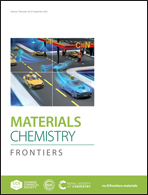Small molecule dopant-free dual hole transporting material for conventional and inverted perovskite solar cells†‡
Abstract
Interfacial layers play very important roles in perovskite solar cells and the enormous diversity of reported materials has contributed to the outstanding progress of these photovoltaic devices. Nevertheless, the interfacial materials are commonly developed to be used in solar cells with a specific architecture, either conventional (n–i–p) or inverted (p–i–n). We report the exceptional performance of a small molecule, whose structural features, based on hydrogen bond-directed self-assembly, allow its application as hole transporting layer (HTL) in n–i–p and p–i–n perovskite solar cells with the same efficiency. This particularity has been investigated through a comparative study with a very similar molecule that cannot self-assemble, evidencing the benefits of the structural integrity of hydrogen bonded HTLs in terms of charge extraction and recombination, independently on the device architecture.

- This article is part of the themed collections: FOCUS: Perovskite Materials and Devices, 2023 Materials Chemistry Frontiers HOT articles and Materials Chemistry Frontiers Most Popular Articles 2023


 Please wait while we load your content...
Please wait while we load your content...